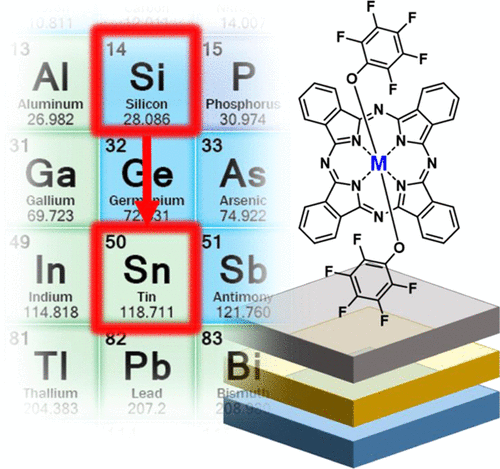当前位置:
X-MOL 学术
›
ACS Appl. Electron. Mater.
›
论文详情
Our official English website, www.x-mol.net, welcomes your feedback! (Note: you will need to create a separate account there.)
Contact Engineering Using Manganese, Chromium, and Bathocuproine in Group 14 Phthalocyanine Organic Thin-Film Transistors
ACS Applied Electronic Materials ( IF 4.7 ) Pub Date : 2020-03-24 , DOI: 10.1021/acsaelm.0c00104 Owen A. Melville 1 , Trevor M. Grant 1 , Kate Lochhead 1 , Benjamin King 1 , Ryan Ambrose 2 , Nicole A. Rice 1 , Nicholas T. Boileau 1 , Alexander J. Peltekoff 1 , Mathieu Tousignant 1 , Ian G. Hill 2 , Benoît H. Lessard 1
ACS Applied Electronic Materials ( IF 4.7 ) Pub Date : 2020-03-24 , DOI: 10.1021/acsaelm.0c00104 Owen A. Melville 1 , Trevor M. Grant 1 , Kate Lochhead 1 , Benjamin King 1 , Ryan Ambrose 2 , Nicole A. Rice 1 , Nicholas T. Boileau 1 , Alexander J. Peltekoff 1 , Mathieu Tousignant 1 , Ian G. Hill 2 , Benoît H. Lessard 1
Affiliation

|
Silicon and tin(IV) phthalocyanines, which have been demonstrated as simple-to-synthesize materials for n-type organic thin-film transistors (OTFTs), have relatively shallow lowest unoccupied molecular orbital (LUMO) levels that create a Schottky barrier with the gold source–drain contacts typically used in device fabrication. To reduce the contact resistance (RC) associated with this barrier and improve the OTFT performance, we fabricated bottom-gate top-contact (BGTC) devices using low-work-function metals (Mn/Cr) and an electron dopant material (bathocuproine, BCP) as contact interlayers. We characterized two tin phthalocyanines (SnPcs), tin bis(pentafluorophenoxy)phthalocyanine (F10-SnPc) and tin bis(2,4,6-trifluorophenoxy)phthalocyanine (246F-SnPc), as organic semiconductors (OSCs) and compared them to their silicon phthalocyanine (SiPc) analogues. We found that using Mn and Cr interlayers with SiPc OTFTs reduces RC to as low as 11.8 kΩ cm and reduces the threshold voltage (VT) to as low as 7.8 V while improving linear region characteristics compared to devices using silver or gold electrodes only. BCP interlayers appear to reduce VT in all SiPc and SnPc devices and increase the off-state conductivity of SnPc devices if covering the entire OSC. Overall, this work demonstrates the potential for metal interlayers and solid-state organic interlayers for improving electron transport in low-cost, n-type OTFTs using group 14 phthalocyanines.
中文翻译:

第14组酞菁有机薄膜晶体管中使用锰,铬和浴铜的接触工程
硅和锡(IV)酞菁已被证明是n型有机薄膜晶体管(OTFT)的易于合成的材料,具有相对较浅的最低未占据分子轨道(LUMO)含量,可与肖特基势垒形成肖特基势垒。金源-漏极触点通常用于设备制造。为了降低与该势垒相关的接触电阻(R C)并提高OTFT性能,我们使用低功函数金属(Mn / Cr)和电子掺杂材料(bathocuproine)制造了底栅顶接触(BGTC)器件。 ,BCP)作为接触中间层。我们对两种锡酞菁(SnPcs),双(五氟苯氧基)锡酞菁锡(F 10-SnPc)和双(2,4,6-三氟苯氧基)锡酞菁(246F-SnPc),作为有机半导体(OSC),并将它们与其硅酞菁(SiPc)类似物进行了比较。我们发现,与仅使用银或金电极的器件相比,将Mn和Cr中间层与SiPc OTFT一起使用可将R C降低至11.8kΩcm ,并将阈值电压(V T)降低至7.8 V,同时改善了线性区域特性。BCP中间层似乎降低了V T如果覆盖整个OSC,则可在所有SiPc和SnPc器件中使用它,并增加SnPc器件的截止态电导率。总体而言,这项工作证明了金属中间层和固态有机中间层具有改善使用第14号酞菁的低成本n型OTFT中电子传输的潜力。
更新日期:2020-03-24
中文翻译:

第14组酞菁有机薄膜晶体管中使用锰,铬和浴铜的接触工程
硅和锡(IV)酞菁已被证明是n型有机薄膜晶体管(OTFT)的易于合成的材料,具有相对较浅的最低未占据分子轨道(LUMO)含量,可与肖特基势垒形成肖特基势垒。金源-漏极触点通常用于设备制造。为了降低与该势垒相关的接触电阻(R C)并提高OTFT性能,我们使用低功函数金属(Mn / Cr)和电子掺杂材料(bathocuproine)制造了底栅顶接触(BGTC)器件。 ,BCP)作为接触中间层。我们对两种锡酞菁(SnPcs),双(五氟苯氧基)锡酞菁锡(F 10-SnPc)和双(2,4,6-三氟苯氧基)锡酞菁(246F-SnPc),作为有机半导体(OSC),并将它们与其硅酞菁(SiPc)类似物进行了比较。我们发现,与仅使用银或金电极的器件相比,将Mn和Cr中间层与SiPc OTFT一起使用可将R C降低至11.8kΩcm ,并将阈值电压(V T)降低至7.8 V,同时改善了线性区域特性。BCP中间层似乎降低了V T如果覆盖整个OSC,则可在所有SiPc和SnPc器件中使用它,并增加SnPc器件的截止态电导率。总体而言,这项工作证明了金属中间层和固态有机中间层具有改善使用第14号酞菁的低成本n型OTFT中电子传输的潜力。


























 京公网安备 11010802027423号
京公网安备 11010802027423号